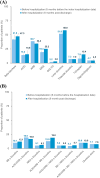Initiation and continuation of pharmacological therapies in patients hospitalized for heart failure in Japan
- PMID: 38643208
- PMCID: PMC11032365
- DOI: 10.1038/s41598-024-60011-y
Initiation and continuation of pharmacological therapies in patients hospitalized for heart failure in Japan
Erratum in
-
Author Correction: Initiation and continuation of pharmacological therapies in patients hospitalized for heart failure in Japan.Sci Rep. 2024 Oct 15;14(1):24193. doi: 10.1038/s41598-024-75133-6. Sci Rep. 2024. PMID: 39406947 Free PMC article. No abstract available.
Abstract
Currently, the utilization patterns of medications for heart failure (HF) after worsening HF events remain unelucidated in Japan. Here, we conducted a retrospective cohort study evaluating the changes in HF drug utilization patterns in 6 months before and after hospitalizations for HF. The adherence to newly initiated HF medications was evaluated based on the proportion of days covered (PDC) and persistence as continuous treatment episodes among new users. The study included 9091 patients hospitalized for HF between January 2016 and September 2019, including 2735 (30.1%) patients who were newly prescribed at least one HF medication after hospitalization. Despite increases in the use of foundational HF therapy (beta-blockers, angiotensin-converting-enzyme inhibitors/angiotensin receptor blockers, or mineralocorticoid receptor antagonists), 35.6% and 7.6% of patients were treated with the HF foundational monotherapy or diuretics alone after hospitalization, respectively. The mean PDC of newly initiated HF medications ranged from 0.57 for thiazide diuretics to 0.77 for sodium-glucose cotransporter-2 inhibitors. Continuous use of HF medications during the first year after initiation was observed in 30-60% of patients. The mean PDC and one-year continuous HF medication use were consistently lower in patients aged ≥ 75 years and in patients with a history of HF hospitalization for all HF medication classes except for tolvaptan and digoxin. Despite the guideline recommendations of HF pharmacotherapy, both treatment and adherence were suboptimal after HF hospitalization, especially in vulnerable populations such as older patients and those with prior HF hospitalizations.
© 2024. The Author(s).
Conflict of interest statement
S.O., M.T., T.T., C.O., T.E., and A.M. are employed by Bayer. C.L., H.R., M.A., and Z.M. are employees of Aetion, Inc. and hold stock options of Aetion, Inc. In this study, Aetion Inc. performed the statistical analysis following the statistical analysis plan.
Figures





Similar articles
-
Treatment Initiation Patterns, Modifications, and Medication Adherence Among Newly Diagnosed Heart Failure Patients: A Retrospective Claims Database Analysis.J Manag Care Spec Pharm. 2016 May;22(5):561-71. doi: 10.18553/jmcp.2016.22.5.561. J Manag Care Spec Pharm. 2016. PMID: 27123917 Free PMC article.
-
Adherence and persistence to pharmacotherapy in patients with heart failure: a nationwide cohort study, 2014-2020.ESC Heart Fail. 2023 Feb;10(1):405-415. doi: 10.1002/ehf2.14206. Epub 2022 Oct 20. ESC Heart Fail. 2023. PMID: 36266969 Free PMC article.
-
Treatment prescription, adherence, and persistence after the first hospitalization for heart failure: A population-based retrospective study on 100785 patients.Int J Cardiol. 2021 May 1;330:106-111. doi: 10.1016/j.ijcard.2021.02.016. Epub 2021 Feb 11. Int J Cardiol. 2021. PMID: 33582198
-
Initiation, Continuation, Switching, and Withdrawal of Heart Failure Medical Therapies During Hospitalization.JACC Heart Fail. 2019 Jan;7(1):1-12. doi: 10.1016/j.jchf.2018.06.011. Epub 2018 Nov 7. JACC Heart Fail. 2019. PMID: 30414818 Free PMC article. Review.
-
Benefits and Risks of Continuing Angiotensin-Converting Enzyme Inhibitors, Angiotensin II Receptor Antagonists, and Mineralocorticoid Receptor Antagonists during Hospitalizations for Acute Heart Failure.Cardiorenal Med. 2020;10(2):69-84. doi: 10.1159/000504167. Epub 2020 Feb 14. Cardiorenal Med. 2020. PMID: 32062648 Review.
References
-
- Farmakis, D., Stafylas, P., Giamouzis, G., Maniadakis, N. & Parissis, J. The medical and socioeconomic burden of heart failure: A comparative delineation with cancer. Int. J. Cardiol.15(203), 279–281 (2016). - PubMed
-
- Savarese, G. et al. Global burden of heart failure: A comprehensive and updated review of epidemiology. Cardiovasc. Res.118(17), 3272–3287 (2023). - PubMed
-
- Okura, Y. et al. Impending epidemic: Future projection of heart failure in Japan to the year 2055. Circ. J.72(3), 489–491 (2008). - PubMed
-
- Rugiómez, A., Michel, A., Martín-Pérez, M. & Rodríguez, L. A. G. Heart failure hospitalization: An important prognostic factor for heart failure re-admission and mortality. Int. J. Cardiol.220, 855–861 (2016). - PubMed
MeSH terms
Substances
LinkOut - more resources
Full Text Sources
Medical
Research Materials
Miscellaneous

